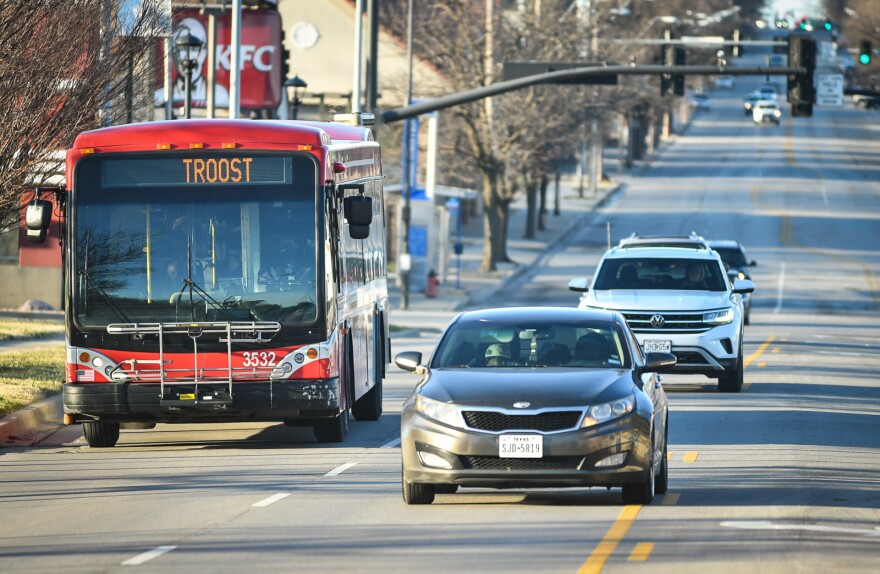Anthony Cunningham doesn’t own a car, and hasn’t the whole time he’s lived in Kansas City.
“I am transit-dependent and I use our bus system a heck of a lot to get around,” he said.
Cunningham, a 26-year-old organizer with the Kansas City chapter of the climate action group Sunrise Movement, recently moved to the Union Hill neighborhood. He said money partially drove his decision to live without a car in a car-centric city.
“Being a young person who's had to pay off almost $30,000 in student loans, it was certainly part of the calculus of wanting to live car-free,” Cunningham said.
It helps, too, that riding the bus has been free for Cunningham and thousands of other regular bus riders for the past three years. But free rides have come at a cost to the Kansas City Area Transportation Authority and the city.
Now, three years after eliminating fares — which made Kansas City the first major U.S. city to make public transit free — the KCATA is studying the possibility of reintroducing bus fares.
The study involves a financial analysis looking into how fare elimination has impacted the agency’s revenues, and then estimating potential revenue the agency would receive if fares are reinstated. The agency will make its final recommendation on whether to reintroduce fares in December.
Richard Jarrold, vice president of regional planning and development at the KCATA, said the board is studying multiple options.
“Could we still provide zero fare for those really that need it? What would those systems look like?” he said. “So there are a lot of things to take a look at.”
Cunningham hopes the buses continue to be free.
“Not only does it help a lot of poor and working-class Kansas Citians, it also helps with reliability,” he said. “Because if there's 10 people trying to get on the bus and each of them doesn't have to pay, it helps make sure that that bus can get out of that stop quicker.”
Impact of fares on KCATA
Before 2020, bus fares were $1.50. Veterans and students could ride for free. The fares made up between 7% and 12% of the agency’s total revenue.
Between 2011 and 2014, passenger fares brought in about $12 million annually, reflecting high ridership numbers.
In 2019, the last year before Kansas City eliminated bus fares, the agency collected $9 million in passenger revenue — about 7% of the KCATA’s total revenues that year.
Last year, the KCATA collected $698,327 through passenger revenue — a drastic 92% decrease. Though the KCATA doesn’t charge bus fare in routes that serve Kansas City, it still charges for its microtransit programs, RideKC Freedom and its newest venture, IRIS.
When the Kansas City Council voted to eliminate fares in 2019, the city also agreed to cover a portion of the money that would have come from passenger fares. In 2021, the first full year of fare-free buses, Kansas City allocated $3.2 million to the agency. Last year, the city provided $4.8 million. That money came from Kansas City’s half-cent sales tax to support public transit.
Cunningham talks to bus riders as part of the Sunrise Movement’s Better Buses campaign, and said zero fare is a popular policy.
He questioned how fare, if it’s reintroduced, would be collected. When agency staff presented to the KCATA Board of Commissioners last month, they highlighted ease of use and affordability as goals in studying fare collection.
Nicholas Miller, president of the local Amalgamated Transit Union, said bus operators would prefer bus fares come back. He said the zero-fare program was implemented without a structure.
“Frank White (III, KCATA’s director) and his team are doing a great job of making sure that they start putting more structure in place by increasing the security and putting stricter guidelines as far as people just arbitrarily riding around,” he said.
Other funding sources
Kansas City’s three-eighths cent sales tax is the largest local source of KCATA funding — and voters resoundingly renewed it for another decade earlier this week.
Last year, money collected from the 3/8ths cent sales tax made up 29.5% of the KCATA’s operating revenue of $100.9 million.
Public transit advocates were concerned that if the sales tax renewal hadn’t passed, the agency would have drastically cut service and labor.
The half-cent sales tax makes up about 26% of the agency’s total revenues.
The agency also receives money from the federal government. In 2022, COVID relief funds made up about 16.6% of the agency’s revenue.
But that money won’t last forever, which pushed the KCATA board to look at other funding sources in addition to charging fares again.
“It is certainly important for other communities in the region to help contribute towards the funding”, Jarrold said. “We think the private sector has a role to play as well, of beneficiaries of the transit services and even new services.”
At the same time revenue from passenger fare has dropped, the agency’s expenses have grown. In the 2023 budget, the agency’s operating expenses were $117 million, an increase from $100 million last year.
Jarrold attributes the rise in expenses to inflation and the agency’s decision to raise pay for bus operators.
Riders return as pandemic eases
The agency has seen its ridership numbers bounce back this year after seeing decreases due to the COVID-19 pandemic.
So far this year, nearly 9 million people have ridden on KCATA. Last year, there were 10 million total riders. The KCATA saw its best year in ridership in 2012, when the agency saw nearly 15 million riders. In September 2023, the most recent month of data available from the KCATA, there were 1,066,966 bus riders — slightly more than the number of bus riders in September 2019.
“We are above a million rides per month,” Jarrold said. “We are pre-COVID ridership levels and we believe zero fare had a role to play in that positive impact on ridership.”







